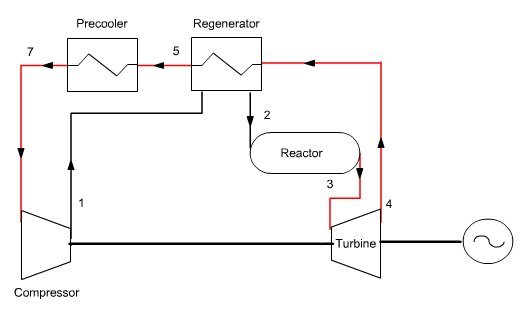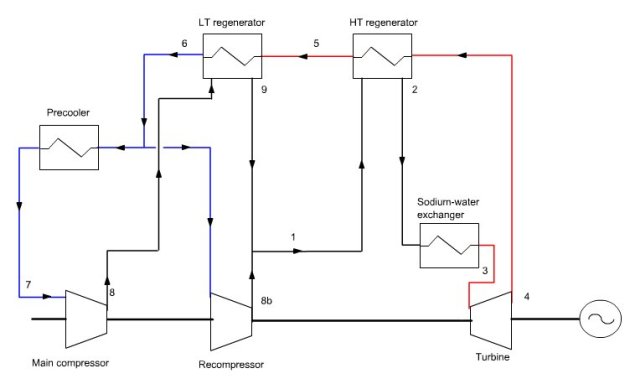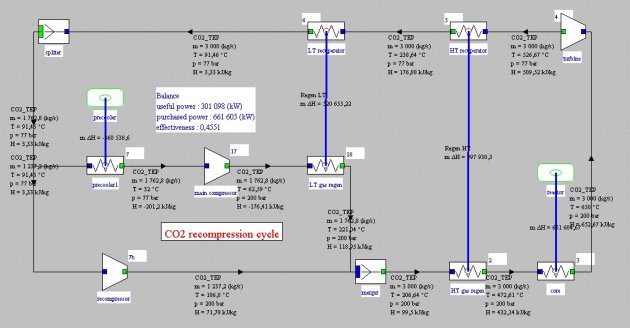Supercritical CO2 cycles
MIT has recently worked on cycles using supercritical carbon dioxide, which it considers lead to better performance than others to produce electricity from nuclear reactors at moderate temperatures between 650 and 800 °C.
Proponents of these cycles argue that efficiencies are, for this temperature range, higher than those of steam cycles and that machines are much more compact.
Several types of supercritical CO2 cycles are considered: the simplest is a Brayton cycle with regenerator (Figure below) the principal variants involving partial cooling, pre-compression or recompression.
Simple regeneration cycle

On the thermodynamics, the value of using such a cycle is to benefit from a compression work in supercritical liquid much lower than if the working fluid remains in the gaseous state as in a classic Brayton cycle.
In a 350-MWe supercritical CO2 simple regenerative cycle (Figure below), a flow of 3 t/s of CO2 at 200 bar enters the reactor at a temperature of 330 °C and leaves it at 650 °C. It is then expanded at the pressure of 77 bar in a turbine. Regeneration takes place between expanded CO2 and that which enters the reactor. CO2 then enters the cooler, which it leaves at 32.5 °C, before being sucked into the compressor, which brings it at 200 bar.
The efficiency of this cycle remains fairly low, close to 35% with a regenerator of effectiveness 0.9 and polytropic effi ciency turbomachinery equals to 0.9.

Recompression cycle
In a recompression cycle (Figure below), compression is two-stage with intermediate cooling of only a portion of the fluid, which allows recycling of a larger amount of heat.
The main flow of CO2 (3 t/s) leaving the turbine passes through a high temperature regenerator (4-5) and then in a low temperature one (5-6), before being split in two.
60% of the flow is cooled in a precooler (6-7), then compressed in the main compressor from 77 to 200 bar (7-8), and heated in the LT regenerator (8-9).
The remaining CO2 flow is compressed at 200 bar in the recompressor (6-8b), then mixed with another stream exiting the LT regenerator (1), and the total flow is heated in the HT regenerator (1-2) before entering the reactor.
CO2 exiting the reactor is then expanded in the turbine (3-4), and the cycle is thus closed.
In this case, the reactor inlet temperature is higher, and with the same assumptions as before on the polytropic efficiency of turbomachinery (0.9) and exchanger effectiveness (0.9), the capacity remains close to 300 MWe, and the efficiency exceeds 45% (Figure below). Even higher values are hoped for, the order of 50%, with exchanger effectiveness around 95%.
Supercritical CO2 cycles appear very interesting in thermodynamic terms. The two main technological constraints are the realization of regenerators in the circum-critical zone in particular to avoid any temperature crossing, and that of turbomachinery effective for CO2, an area where there is no reference. Moreover, these cycles can only work if the CO2 state at the precooler output is supercritical, which implies a temperature limit of 32 °C, which can be difficult to achieve when the cold source is outside air, a river or sea water.
Book reference
Chapter 24 (Part 4)
Exercises and personal activities
An exercise is proposed (it is preferable that you use a server such as CTP Lib to represent the thermodynamic properties of CO2). Its correction will provide the Thermoptim files allowing you to model the cycle presented above.
References
V. DOSTAL, M.J. DRISCOLL, P. HEJZLAR, N.E. TODREAS, A Supercritical CO2 Gas Turbine Power Cycle For Next-Generation Nuclear Reactors, Proc. ICONE-10, Arlington, Virginia, April 14-18, 2003.
V. DOSTAL, A Supercritical Carbon Dioxyde Cycle For Next-Generation Nuclear Reactors, PhD thesis, MIT, january 2004.


